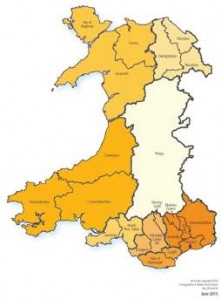 LAST week Leighton Andrews, Public Services Minister for Wales, published the Welsh Government’s preferred plans for redrawing the map of local government in Wales. The plans unveiled had been well trailed and boil down to recreating the large unitary authorities that were part of the Welsh civic and political landscape for 22 years up to 1996.
LAST week Leighton Andrews, Public Services Minister for Wales, published the Welsh Government’s preferred plans for redrawing the map of local government in Wales. The plans unveiled had been well trailed and boil down to recreating the large unitary authorities that were part of the Welsh civic and political landscape for 22 years up to 1996.
In Wales’ fiercely independent west, the vision presented by the Welsh Government means recreating Dyfed. It appears, however, that the Welsh Government faces not only an uphill battle to get its reorganisation plans accepted by grassroots councillors, but also a stiff challenge to the prospect of even getting them on the statute book at all.
Council l eaders speak out
The issue highlighted by all of West Wales’ council leaders is that of cost and the threat to local accountability.
Cllr Ellen ap Gwynn, Leader of Ceredigion County Council, said: “Ceredigion County Council has previously voted unanimously against any merger proposals; this stance remains unchanged. Merging with any other authority would weaken local accountability, and so it is in the county’s citizens’ best interests to retain the sovereignty of Ceredigion. As the WLGA has recommended, local accountability would be best served by employing a combined authority model, which would consist of Ceredigion, Powys and Carmarthenshire cooperating on common strategic matters – an arrangement which would also negate any democratic deficit. Ceredigion remains committed to cooperate with other Councils to share resources and expertise in order to secure the most efficient and effective services possible. Bearing in mind that the Council has already made savings of £25 million over the past three years and needs to make similar savings over the next three years, concentrating on these proposals does not offer any benefits for the people of the county. It would be much better to see the estimated £268m cost of these proposals being spent on local services, rather than taking an empty, expensive step back in time.”
In a press statement last week, Cllr Emlyn Dole, Leader of Carmarthenshire, offered a more poetic view of the situation: “We have in Carmarthenshire a distinctiveness in culture, language and heritage – these are precious, and ours to retain and nurture. To that end, I firmly believe that Carmarthenshire should stand alone as a local authority in any future reorganisation of local government. One of my last acts as leader of the opposition on Carmarthenshire County Council, before becoming Leader, was to put down a motion on notice making this very point. I also put to council that maintaining our status as a county and an area authority offers us the best opportunity to safeguard and improve our services, and enables us to continue with the regeneration of our local economy. I was pleased to see cross party support, with all members – bar one – giving their full support. Having said that, I am not an inflexible Leader, and I will listen to all arguments for and against – indeed I do merit regional working arrangements.”
Cllr Jamie Adams, Leader of Pembrokeshire, was equally keen on retaining the distinctiveness of his county: “Seeing the maps for the first time, it is difficult to comment without some explanation of the rationale behind it. My position has always been: will the change improve the services we deliver to the public while at the same time reducing costs? If it doesn’t tick those two boxes, I think it is right to question the validity of this exercise. Apart from the obvious loss of local decision-making and accountability, I also have concerns about the real damage reorganisation could do to a very successful brand. I am referring to the Pembrokeshire name which is instantly recognisable to those living far outside our County and even beyond Wales. A large number of local businesses in tourism, agriculture, food and energy depend on, and identify strongly, with brand Pembrokeshire for their livelihood. I fear they will inevitably suffer if amalgamation goes ahead and in these trying times I believe it would be foolish to gamble with the health of our local economy.”
Big is beautiful ,but not always
There is no doubt that bigger authorities are better able to administer some key local government services. Strategic planning and transport, education and social services all demand scale. Size can bring vision, specialist expertise and economy and flexibility in the use of resources. For these services, big is beautiful and a reduction in the number of local authorities is right. It might even be that 8 or 9 authorities are too many, particularly in respect of strategic planning and transport.
But sometimes small is beautiful as well. Local authorities ought to be more than just the deliverers of services, and councils that don’t obviously connect with the places they serve struggle to be civic leaders and place-makers. The performance of Wales’ biggest councils also shows that big isn’t necessarily better.
Despite the clarion calls of the city-region lobby, most of Wales consists of small towns and villages, and we ignore the governance and provision of services in these communities at our peril. It remains to be seen if the proposed role for town and community councils will fill this gap.
Plaid Cymru has tapped into this picture with its own proposals for reorganisation. Plaid’s response is to create regional consortia to deliver the services identified above, while retaining a direct link with the local electorate by retaining other services at the existing county level. In a debate in the Senedd, Carwyn Jones di smi s sed this plan as ‘creating seven new quangos’, but Plaid’s policy seems to bear remarkable similarities to that favoured by the Welsh Local Government Association.
Cllr Bob Wellington CBE, Labour leader of Torfaen and head of the WLGA, says: “The sustainability of authorities in Wales is in question over the next three years and it is time to examine all options for reforming public services across the board. This means looking at greater integration of health and social care, freeing up authorities from Government bureaucracy and regulation and also empowering local communities through their councils.”
As Mike Hedges AM, presciently wrote in a paper for the Bevan Foundation: ‘The last 40 years have seen two reorganisations, the creation of the National Assembly for Wales and services such as water, post-16 education and Magistrates’ courts being taken out of local authority control. After almost a hundred years with a stable structure, Local government in Wales was reorganised into county and district Councils in 1974 and further reorganised into 22 unitary authorities in 1996. If we continue changing local government structures every 22 years then we are due an Act in 2016 and a new structure in place by 2018’.
The case for reform
Not all visions of reorganisation are as apocalyptic as those offered by local government leaders. Wales Politico carries an article which cites two unnamed senior council officials as accepting that the need and case for reorganisation is overwhelming. The article quotes a South Wales officer as saying: “Everyone in local government knows it is the correct decision. But obviously we can’t say that publicly, because so many jobs will go – including our own.”
Writing in Click on Wales, Geraint Talfarn Davies goes as far to say that: “Fewer larger counties should entail a rejuvenation of this bottom tier, in ways that would encourage really local action. It has been the missing dimension in the debate. Those who want to see real local engagement should opt for fewer councils at the top and genuinely local entities at the very bottom, even more local than the existing councils. The message from a public that seems increasingly more concerned by quality of delivery than by democratic form is, for God’s sake get on with it, do it better, get results.”
Describing the progress of the reforms as ‘snail-paced’ and ‘ham-fisted’, The Daily Wales observed: ‘The reality is that just as turkeys will never vote for Christmas, local authority leaders will never vote for their own abolition’.
Whatever the future holds for Welsh local government, it seems that – with no hope of getting legislation through before 2016’s Assembly elections – the debate is going to run and run.
The question is, who will blink first?
















Add Comment